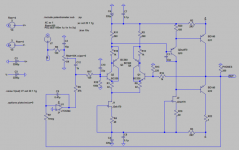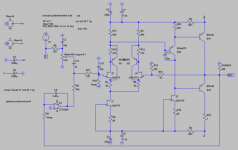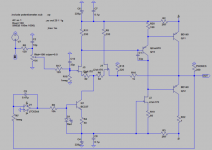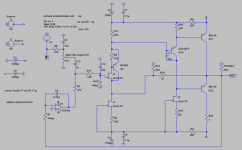I just modded the amp to differential input, 2 x SK170. DC-wise it measures exactly like predicted by LTSpice . It sounds less distorted and more laid back. Maybe more "transistor like", I don't know. Slighly more noise. I'm going to "burn in" the new components and listen some more.
. It sounds less distorted and more laid back. Maybe more "transistor like", I don't know. Slighly more noise. I'm going to "burn in" the new components and listen some more.
It sounds good. Compared to Mini3 (AD8397/OPA690), it's more laid back, smoother and more enjoyable. Mini3 is fairly neutral but a bit harsh and forward... and quite "transistor sounding".
Later I'll try bipolar differential input. It should be more or less just roll the transistors, I think.
It's fun to explore different topologies .
.
It sounds good. Compared to Mini3 (AD8397/OPA690), it's more laid back, smoother and more enjoyable. Mini3 is fairly neutral but a bit harsh and forward... and quite "transistor sounding".
Later I'll try bipolar differential input. It should be more or less just roll the transistors, I think.
It's fun to explore different topologies
nelsonvandal said:I just modded the amp to differential input, 2 x SK170.
...It sounds good. .....
It's fun to explore different topologies.
hi
If you like to explore JLH variations you can have a look at this amp too:
http://fabaudio.googlepages.com/jlh-fabclassapoweramp
I guess I'll have to find some spice models for MOSFETs and start playing around.fab said:
hi
If you like to explore JLH variations you can have a look at this amp too:
http://fabaudio.googlepages.com/jlh-fabclassapoweramp

Back to JLH with diff input. When using JFETs, diff stage is a major improvement. It's more neutral without being boring. I listened "all" day yesterday, 'til the batteries ran down, without fatigue and yet excitement. It's warm without being grainy, and not too laid back.
Now I've tried bipolar differential input, BC550 from Fairchild. I like it better with JFETs in this amp. This is a very good amp now, and I can recommend it. The mod isn't too hard to do. For a standard JLH a p-channel JFET like SJ74 has to be used.
I do think there's a difference between JFET and bipolar input stages. Where JFET sounds a bit grainy, focused center information (like voices) and "pin point" imaging, dry, firm bass etc and bipolar sounds clean, smooth, "wet", "free floating" or a vaguer imaging, soft bass.
The results have been the same in all my discrete amps, and the results are valid with all the opamps I've tried (with one or two exceptions) - quite a bunch of them. The only JFETs I've tried are SK170/J74, and the biploars I've tried are BC549/550/559/560/327/337 from Philips, BC550/560 from Fairchild and SC2240/SA970 from Toshiba. The BCs are softer sounding than the Toshibas.
I do think there's a difference between JFET and bipolar input stages. Where JFET sounds a bit grainy, focused center information (like voices) and "pin point" imaging, dry, firm bass etc and bipolar sounds clean, smooth, "wet", "free floating" or a vaguer imaging, soft bass.
The results have been the same in all my discrete amps, and the results are valid with all the opamps I've tried (with one or two exceptions) - quite a bunch of them. The only JFETs I've tried are SK170/J74, and the biploars I've tried are BC549/550/559/560/327/337 from Philips, BC550/560 from Fairchild and SC2240/SA970 from Toshiba. The BCs are softer sounding than the Toshibas.
After recommendations regarding JFET biasing, I increased the current to about 4 mA each for the SK170's. It's less grainy, I think, but still has a sound of it's own - coloration. It's still warmer than neutral, and lacks a bit of sparkle at the top. But this is a highly enjoyable amp. I can listen for hours without getting fatigued.
But... I was inspired by that article about memory distortion and tried a bipolar CFP diff input using BC550 and BC559. Gone is the warm and grainy coloration, for good and for bad. This is more neutral, almost no coloration, maybe a little "gray" and unispiring.
But... I was inspired by that article about memory distortion and tried a bipolar CFP diff input using BC550 and BC559. Gone is the warm and grainy coloration, for good and for bad. This is more neutral, almost no coloration, maybe a little "gray" and unispiring.
Attachments
... and then I changed from BC550 to SK170, still CFP. Woa!, now it's neutral without being gray. I've only listened to a couple of songs, and I guess after longer listening I'll hear some kind of coloration, but this is very close to perfect.
Too bad I can't fit it inside my amp , the input stage is on adapters. I guess I have to make new boards.
, the input stage is on adapters. I guess I have to make new boards.
Too bad I can't fit it inside my amp
 , the input stage is on adapters. I guess I have to make new boards.
, the input stage is on adapters. I guess I have to make new boards.Attachments
I wonder if cascoding would be an improvement or not. Would current mirrors improve things? And what If I made the whole amp complementary, with cascoded VAS? So many options. Maybe next time.
I'd like a DC servo outside the signal path, so I could ditch the input cap. I've tried this one but it oscillated. Any Ideas?
I'd like a DC servo outside the signal path, so I could ditch the input cap. I've tried this one but it oscillated. Any Ideas?
Attachments
nelsonvandal said:... and then I changed from BC550 to SK170, still CFP. Woa!, now it's neutral without being gray. I've only listened to a couple of songs, and I guess after longer listening I'll hear some kind of coloration, but this is very close to perfect.
Too bad I can't fit it inside my amp, the input stage is on adapters. I guess I have to make new boards.
Hi
I am following your experiment closely and it is very inspiring to me.

In fact I have already done similar type experiments in my modified DH-200 amp. Have you tried to fit a "daughter" board on your main board? See on my web page for example in DH-200 mod section.
For yout listening test do you use a large selection of different recordings and the same ones for comparison?
I have a suggestion for you if you want to try another input stage cascode topology. See fir 14b of this link: http://www.borbelyaudio.com/adobe/ae699bor.pdf
Godd luck and keep us posted on your results!
Yes, I've used a daughter board for these experiments. The problem is size. There's no room for the extra board inside the box.fab said:
Hi
I am following your experiment closely and it is very inspiring to me.
In fact I have already done similar type experiments in my modified DH-200 amp. Have you tried to fit a "daughter" board on your main board? See on my web page for example in DH-200 mod section.
For yout listening test do you use a large selection of different recordings and the same ones for comparison?
I have a suggestion for you if you want to try another input stage cascode topology. See fir 14b of this link: http://www.borbelyaudio.com/adobe/ae699bor.pdf
Godd luck and keep us posted on your results!
I always listen to a lot of recordings to find out how the amp really sounds, and I often use an amplifier in front of the tested amp, to hear what the tested amp adds or subtracts. The first method is more important since an unannoying sound for long time listening is my goal. The second method is very much faster to find colorations though.
It's funny, I read another article by Borebly yesterday. I'm very tempted to try cascoding. I've read so much about it. Some love it others don't. I think I'll have to find out for myself.
Another option would be single end with CFP (and maybe cascode).
Fab, can't you describe what results you got when tweaking your amp? I see you use CFP in stage 2. Was it an improvement? What did cascoding do to the sound? Have you tried resistors instead of current mirrors for the LTP? I'm not sure I like it with current mirrors. I've tried both.
You've made two amps with CFP/cascode input stage. How do they compare to the JLH-like amp?
I am also JLH addicted... the best sound i have listened
... but hot... class A.... very hot.
Graham made better, his GEM sounds even better than JLH, and was a development that started with Graham Maynard studying the JLH circuit.
The GEM has dual output circuits, one is a class A, draining half ampere if i can remember, and the other is conventional AB output circuit.
I have not listened better class A amplifier than GEM (G.E.M = Graham Ernest Maynard)..... even wonderfull Roender amplifier had some advantage in one sector and lost in another (personal, subjective opinion)
I have abandoned Class A amplifiers.... well.... my research into them.... too much hot to my environment, my temperature is around 30 degrées celsius all long the year, i do not need a thermometer, just a needle glued into some 30 degrées Celsius indication... too much hot to Class A amplifiers.
Graham used low current, so, it is not a conventional, a standard class A...it is just a helping extra output transistor, or output stage, working to reduce crossover distortion. to hide it, to attenuate it and to offer you some good watts into pure class A operation.
Mr. Maynard have abandoned our forum because of bad educated folks that invaded to be annoying here...management kicked them out...but Graham was already tired of those things and felt not confortable here, believing any idiot can enter to disturb... he felt moderators too much tollerant with those invaders.
I have started to make mine amplifiers... also based into Graham designs... and i also remove myself from the thread that has lost the main guy.
Now a days i am accepting to listen second class audio, buiding and creating Class AB circuits... they cannot be compared with Class A... they loose!...but at least they do not cook me inside my home
regards,
Carlos
... but hot... class A.... very hot.
Graham made better, his GEM sounds even better than JLH, and was a development that started with Graham Maynard studying the JLH circuit.
The GEM has dual output circuits, one is a class A, draining half ampere if i can remember, and the other is conventional AB output circuit.
I have not listened better class A amplifier than GEM (G.E.M = Graham Ernest Maynard)..... even wonderfull Roender amplifier had some advantage in one sector and lost in another (personal, subjective opinion)
I have abandoned Class A amplifiers.... well.... my research into them.... too much hot to my environment, my temperature is around 30 degrées celsius all long the year, i do not need a thermometer, just a needle glued into some 30 degrées Celsius indication... too much hot to Class A amplifiers.
Graham used low current, so, it is not a conventional, a standard class A...it is just a helping extra output transistor, or output stage, working to reduce crossover distortion. to hide it, to attenuate it and to offer you some good watts into pure class A operation.
Mr. Maynard have abandoned our forum because of bad educated folks that invaded to be annoying here...management kicked them out...but Graham was already tired of those things and felt not confortable here, believing any idiot can enter to disturb... he felt moderators too much tollerant with those invaders.
I have started to make mine amplifiers... also based into Graham designs... and i also remove myself from the thread that has lost the main guy.
Now a days i am accepting to listen second class audio, buiding and creating Class AB circuits... they cannot be compared with Class A... they loose!...but at least they do not cook me inside my home
regards,
Carlos
So I tried cascoding the input, SK170 cascoding another SK170. This is better than the standard diff input stage, but in this amp CFP sounds better. I haven't tried both CFP and cascodes, but I suppose it's even better.
I don't agree with the guy who wrote about memory distortion, CFP is better than cascodes, in this amp. Maybe it has something to to with mixing JFETs and bipolars, not constant power . It was when he introtuced a JFET to the bipolar input stage things got better, and I find a JFET/bipolar CFP to sound better than bipolar/bipolar one.
. It was when he introtuced a JFET to the bipolar input stage things got better, and I find a JFET/bipolar CFP to sound better than bipolar/bipolar one.
Regarding current mirrors, I don't like them. I've just tried one setup, BC560 with 100R on the emitters. It just sounds worse than using resistors. With CFP and resistors the sound is so close to perfect, I'm not going to bother with trying to find a better current mirror.
Finally I tried a single end CFP. This is very good. Almost as good as the diff stage with CFP. If I can fit this on the board, I'll stick with this. It's good enough (but it should belong in another thread now). After this, maybe I should try the phase splitter with CFP.
I don't agree with the guy who wrote about memory distortion, CFP is better than cascodes, in this amp. Maybe it has something to to with mixing JFETs and bipolars, not constant power
Regarding current mirrors, I don't like them. I've just tried one setup, BC560 with 100R on the emitters. It just sounds worse than using resistors. With CFP and resistors the sound is so close to perfect, I'm not going to bother with trying to find a better current mirror.
Finally I tried a single end CFP. This is very good. Almost as good as the diff stage with CFP. If I can fit this on the board, I'll stick with this. It's good enough (but it should belong in another thread now). After this, maybe I should try the phase splitter with CFP.
Attachments
Using 2Sk170 to cascode 2SK170 will result in a fairly low Vds for the gain device, probably below 2V, even if you use V grade for the cascode. IMHO, this is not the ideal working point for the gain device (2SK170).
If you do want to make use of the simplicity of the JFET cascode, may I suggest you try J111 as the cascode device. You get a decent voltage across the gain device then.
Best regards,
Patrick
If you do want to make use of the simplicity of the JFET cascode, may I suggest you try J111 as the cascode device. You get a decent voltage across the gain device then.
Best regards,
Patrick
Patrick,
What parameters would suffer? What are the ideal operating points of 2SK170?Using 2Sk170 to cascode 2SK170 will result in a fairly low Vds for the gain device, probably below 2V, even if you use V grade for the cascode. IMHO, this is not the ideal working point for the gain device (2SK170).
Nelson,
you have seemingly changed your mind about J-FETs.
When driven appropriately, your headphones can produce the highest quality sound and are therefore also reveling. In my view, you are making progress, but there are still quite a few muddying details around.
There is something I really like, though: your listening approach, very uncommon. I´m pretty convinced that someday you will build excellent amplifiers.
you have seemingly changed your mind about J-FETs.
When driven appropriately, your headphones can produce the highest quality sound and are therefore also reveling. In my view, you are making progress, but there are still quite a few muddying details around.
There is something I really like, though: your listening approach, very uncommon. I´m pretty convinced that someday you will build excellent amplifiers.
nelsonvandal said:
....
Fab, can't you describe what results you got when tweaking your amp? I see you use CFP in stage 2. Was it an improvement? What did cascoding do to the sound? Have you tried resistors instead of current mirrors for the LTP? I'm not sure I like it with current mirrors. I've tried both.
You've made two amps with CFP/cascode input stage. How do they compare to the JLH-like amp?
Nelson,
Unfortunately, I have not done extensive sound comparison as you do with your headphone amp.
When I read the memory distortion article, I tried it, it measured better on THD than "ordinary" stage and decided to use it for better...or worse. Maybe I am wrong but I try to rely on other peoples experience sometimes....
It is very difficult to determine if a configuration is better or worse since it depends on the way it is implemented (current, voltage, power) in relation to other stages of the amp. Also, the rest of your system and the recordings being played back makes the sound evaluation very subjective. I guess that is the reason why there is no agreement on the "perfect" amp (if it could exist...)
I have 4 DIY amps and they all sound different and with one recording I may prefer one and some other recordings another one. Each amp has its strength and weakness. However, I would say that one that sound definitely different and that I enjoy at this moment is my "JHL-FAB" amp... but it is my lates one so I might be biased....

Lumba Ogir said:fab,
what`s your contribution to the topology?
Lumba, can you clarify your question?
Do you mean the topology from JLH to JLH-FAB?
If so, see http://fabaudio.googlepages.com/jlh-fabclassapoweramp
I do not pretend to contribute but only to try ...
Hm, yes, it seems so. I'm a bit ashamed of my generalisations before. I think it has to do with lowering the distortion by using CFP, cascodes, differentials, complementary design etc.Lumba Ogir said:Nelson,
you have seemingly changed your mind about J-FETs.
Do not be ashamed...generalizations is the result of human intelligence
If you are skilled and have assembled 100 amplifiers, (this is an example only) and all class A have sounded better than class AB (for instance)...it is normal to conclude that class A, probably, results in better sounding amplifier than class AB amplifiers.
Every rule has exception...but inside the rule there are multiple things different than exceptions that makes the rule strong.
Not to create rules because exists exceptions is not a good idea.
Those things; conclude, analise, realize, based into your life experience, are the best contribution someone can give us...needs courage to say things of course.... generalization is good sometimes but have some risks too.
If you do not tell me, after you made the assembling of a 100 amplifiers..not telling me that Class A sounds better...and if i want better sound despite cost, despite heat.... i would have to assemble 100 amplifiers to conclude things that you already know, and could have informed me in advance...this could be a short cut in my life, as i would have the chance to follow your instruction and not to waste time assembling 100 units to learn by myself that class A sounds better..maybe to assemble half of that..only class A to find the one is better.
Sorry...my english is confused...but the logics here has more than one sequence and is really a little bit confused.
regards,
Carlos
If you are skilled and have assembled 100 amplifiers, (this is an example only) and all class A have sounded better than class AB (for instance)...it is normal to conclude that class A, probably, results in better sounding amplifier than class AB amplifiers.
Every rule has exception...but inside the rule there are multiple things different than exceptions that makes the rule strong.
Not to create rules because exists exceptions is not a good idea.
Those things; conclude, analise, realize, based into your life experience, are the best contribution someone can give us...needs courage to say things of course.... generalization is good sometimes but have some risks too.
If you do not tell me, after you made the assembling of a 100 amplifiers..not telling me that Class A sounds better...and if i want better sound despite cost, despite heat.... i would have to assemble 100 amplifiers to conclude things that you already know, and could have informed me in advance...this could be a short cut in my life, as i would have the chance to follow your instruction and not to waste time assembling 100 units to learn by myself that class A sounds better..maybe to assemble half of that..only class A to find the one is better.
Sorry...my english is confused...but the logics here has more than one sequence and is really a little bit confused.
regards,
Carlos
- Status
- This old topic is closed. If you want to reopen this topic, contact a moderator using the "Report Post" button.
- Home
- Amplifiers
- Solid State
- JLH with a differential input stage



